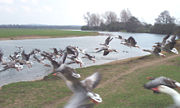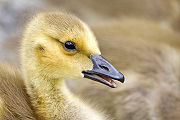Goose
2008/9 Schools Wikipedia Selection. Related subjects: Birds
| Goose | ||||||||||||||||
|---|---|---|---|---|---|---|---|---|---|---|---|---|---|---|---|---|
 Canada Goose, Branta canadensis
|
||||||||||||||||
| Scientific classification | ||||||||||||||||
|
||||||||||||||||
| Genera | ||||||||||||||||
|
Anser |
Goose (plural: geese) is the English name for a considerable number of birds, belonging to the family Anatidae. This family also includes swans, most of which are larger than geese, and ducks, which are smaller.
This article deals with the true geese in the subfamily Anserinae, tribe Anserini.
A number of other waterbirds, mainly related to the shelducks, have "goose" as part of their name.
Description
True geese are medium to large birds, always (with the exception of the Nēnē) associated to a greater or lesser extent with water. Most species in Europe, Asia, and North America are strongly migratory as wild birds, breeding in the far north and wintering much farther south. However, escapes and introductions have led to resident feral populations of several species.
Geese have been domesticated for centuries. In the West, farmyard geese are descended from the Greylag, but in Asia the Swan Goose has been farmed for at least as long.
All geese eat a largely vegetarian diet, and can become pests when flocks feed on arable crops or inhabit ponds or grassy areas in urban environments. They also take invertebrates if the opportunity presents itself; domestic geese will try out most novel food items for edibility.
Geese usually mate for life, though a small number will "divorce" and remate. They tend to lay a smaller number of eggs than ducks but both parents protect the nest and young, which usually results in a higher survival rate for the young geese.
Not all couples are heterosexual, as both females and males will form long-term same-sex couples with greater or lesser frequency depending on species. Of the heterosexual couples, a significant proportion are non-breeding despite having an active sexual life.
Etymology
Goose in its origins is one of the oldest words of the Indo-European languages (Crystal), the modern names deriving from the proto-Indo-European root, ghans, hence Sanskrit hamsa (feminine hamsii), Latin anser, Greek khén etc.
In the Germanic languages, the root word led to Old English gos with the plural gés, German Gans and Old Norse gas. Other modern derivatives are Russian gus and Old Irish géiss; the family name of the cleric Jan Hus is derived from the Czech derivative husa.
The male goose is called a gander (Anglo-Saxon gandra) and the female is the goose ( Webster's Revised Unabridged Dictionary (1913)); young birds before fledging are known as goslings. A group of geese on the ground is called a gaggle; when flying in formation, it is called a wedge or a skein (see also List of collective nouns for birds).
True geese
The following are the living genera of true geese:
- Anser - Grey Geese, including the domesticated goose and the Swan Goose
- Chen - White Geese (often included in Anser)
- Branta - Black Geese, such as the Canada goose
The following two genera are only tentatively placed in the Anserinae; they may belong to the shelducks or form a subfamily on their own:
- Cereopsis - Cape Barren Goose
- Cnemiornis - New Zealand Geese ( prehistoric)
Either these or - more probably - the goose-like Coscoroba Swan is the closest living relative of the true geese.
Fossils of true geese are hard to assign to genus; all that can be said is that their fossil record, particularly in North America, is dense and comprehensively documents a lot of the different species of true geese that have been around since about 10 million years ago in the Miocene. The aptly-named Anser atavus ("Great-great-great-grandfather goose") from some 12 million years ago had even more plesiomorphies in common with swans. In addition, there are some goose-like birds known from subfossil remains found on the Hawaiian Islands. See Anserinae for more.
Other birds called "geese"
There are a number of mainly southern hemisphere birds called "geese", most of which belong to the shelduck subfamily Tadorninae. These are:
- Orinoco Goose, Neochen jubata
- Egyptian Goose, Alopochen aegyptiacus
- The South American sheldgeese, genus Chloephaga
- The prehistoric Madagascar Sheldgoose, Centrornis majori, the "Woodard"
The Blue-winged Goose, Cyanochen cyanopterus belongs either to these, or to lineage closer to ducks.
The Spur-winged Goose, Plectropterus gambensis, is most closely related to the shelducks, but distinct enough to warrant its own subfamily, the Plectropterinae.
The three species of small waterfowl in the genus Nettapus are named "pygmy geese", e.g. the Cotton Pygmy Goose (N. javanica). They seem to represent an ancient lineage like the Cape Barren Goose and the Spur-winged Goose.
A genus of prehistorically extinct seaducks, Chendytes, is sometimes called "diving-geese" due to their large size.
The unusual Magpie-goose is in a family of its own, the Anseranatidae.
The Northern Gannet, a seabird, is also known as the "Solan Goose" although it is a bird unrelated to the true geese, or any other Anseriformes for that matter.


